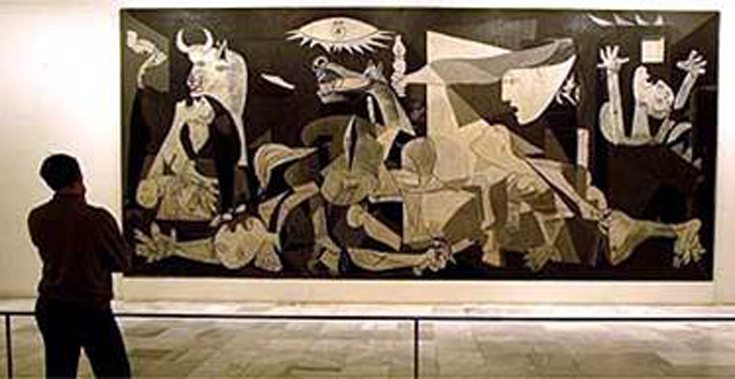Reincarnation Case of Pablo Picasso | Alexandra Nechita: Past Life Patterns & Innate Talent
- CATEGORY
Affirmed by: Spirit Guide or Spirit Being Ahtun Re in a Ryerson-Semkiw Reincarnation Research Session, 2005
From: Born Again
Article by: Walter Semkiw, MD
Alexandra Nechita as Pablo Picasso Reborn
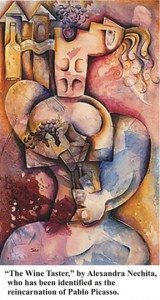 This case was brought to my attention in a casual way. Indeed, the reincarnation case of Pablo Picasso is so self-apparent, that it almost solved itself. Let me explain how the Picasso | Nechita case evolved.
This case was brought to my attention in a casual way. Indeed, the reincarnation case of Pablo Picasso is so self-apparent, that it almost solved itself. Let me explain how the Picasso | Nechita case evolved.
In the summer of 2004, I did a reincarnation presentation in Boulder, Colorado. A member of the audience was a friend of Wayne Peterson, a retired US Diplomat and former Director of the Fulbright Scholarship Program in Washington, DC, who has met four US Presidents: Kennedy, Johnson, Nixon and Clinton. Mr. Peterson’s own reincarnation cases can be reviewed at: Past Lives of Wayne Peterson: A Diplomat, Artist, Socialite and Doge
Wayne’s friend told me that I should investigate a young artist named Alexandra Nechita, as her work is remarkably similar to that of Picasso and it has been speculated that she may be the reincarnation of Picasso. I was advised that Alexandra’s work was being displayed in Denver, at that time, at Gallery M.
The next day, I took a drive to see Alexandra’s work and found myself dumbfounded. Though I had observed how linguistic writing patterns can remain the same across incarnations, such as in the case of John B. Gordon | Jeff Keene, this was the first time I had the opportunity to see how talent could be recapitulated by a painter in such a dramatic way. Later, I would observe how artistic talent and even compositions could be replicated in The Reincarnation Case of Paul Gauguin | Peter Teekamp
Though I am no expert in art, Alexandra’s work was so much like Picasso’s, it was simply striking. I asked the director of Gallery M whether there were any photos of Alexandra available, perhaps on a brochure or business card, and whether I could get contact information for Alexandra. The gallery director told me that no photos of Alexandra were on hand and that the artist was a private person and personal contact information could not be given out. In my next session with Kevin Ryerson, though, I asked Ahtun Re whether Alexandra was indeed the reincarnation of Picasso, which he affirmed.
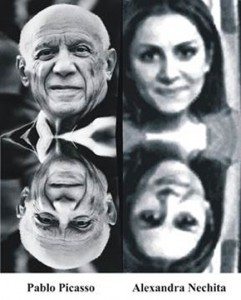 In January 2006, as I was preparing to publish Born Again, on the Internet, I found that Alexandra now had a web site with images of herself. I quickly compared her facial features with Picasso’s and though not as striking as some reincarnation facial matches, I felt her facial architecture was consistent with that of Picasso. Though Alexandra is a beautiful young woman with fine features and Picasso was a rather rugged looking man, the bone structure, the overall architecture of the face and head, I found to be the similar. Later on, I found images of Picasso and Alexandra when they were both children, where a similarity in facial features can also be seen. At this point, I decided to try to contact Alexandra for her inclusion in this book. Little did I know that the subject of reincarnation had already been entertained in her mind.
In January 2006, as I was preparing to publish Born Again, on the Internet, I found that Alexandra now had a web site with images of herself. I quickly compared her facial features with Picasso’s and though not as striking as some reincarnation facial matches, I felt her facial architecture was consistent with that of Picasso. Though Alexandra is a beautiful young woman with fine features and Picasso was a rather rugged looking man, the bone structure, the overall architecture of the face and head, I found to be the similar. Later on, I found images of Picasso and Alexandra when they were both children, where a similarity in facial features can also be seen. At this point, I decided to try to contact Alexandra for her inclusion in this book. Little did I know that the subject of reincarnation had already been entertained in her mind.
Pablo Picasso as a Child Prodigy Artist
Let us briefly review the histories of Pablo Picasso and Alexander Nechita. Picasso was born in Malaga, Spain, on October 25, 1881. Picasso demonstrated artistic gifts early in his boyhood and at the age of 15, he was enrolled in Barcelona’s School of the Fine Arts. His painting, Science and Charity, won a gold medal at an exhibit in Malaga when he was 16 and by this time, Picasso had his own studio in Barcelona.
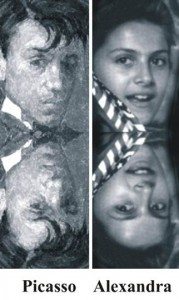 In 1900, Picasso made a brief trip to Paris, where he admired the work of modern artists such as Edgar Degas and Henri Toulouse-Lautrec. Picasso later moved to Paris in 1904 and established friendships with writers, such as Gertrude Stein and Max Jacob. Picasso also witnessed the emerging popularity of Paul Gauguin while he was in Paris and Picasso was influenced by his work.
In 1900, Picasso made a brief trip to Paris, where he admired the work of modern artists such as Edgar Degas and Henri Toulouse-Lautrec. Picasso later moved to Paris in 1904 and established friendships with writers, such as Gertrude Stein and Max Jacob. Picasso also witnessed the emerging popularity of Paul Gauguin while he was in Paris and Picasso was influenced by his work.
With Georges Braque, Picasso pioneered the “Cubist” style of painting, in which landscape images were composed of what appeared to be small cubes. Picasso did sculpture in innovative ways, using a variety of common objects to create abstract constructions. Picasso also became involved in set design, working for the Ballets Russes in Rome. Picasso’s illustrious career culminated in an exhibition at the Louvre, in Paris, which occurred in honor of his 90th birthday, in 1971. With this event, Picasso was the first living artist to have works displayed at the Louvre. Picasso died in France on April 8, 1973.
Past Life Talent: Alexandra Nechita as a Child Prodigy Artist and a “Petite Picasso”
Eight years after Picasso died, on August 27, 1985, Alexandra Nechita was born in Romania. Alexandra’s father, Niko, unfortunately was not present for his daughter’s birth. Niko had left Communist Romania to seek a better future for his family in the United States, when his wife, Viorica, was six months pregnant with Alexandra. Niki would not see his wife and new daughter until 1987, when they were reunited in Los Angeles.
Like Picasso, Alexandra demonstrated artistic talent as a very young child. In fact, Alexandra began to draw as soon as her developing nervous system would allow her to do so. Alexandra became obsessed with her coloring books, which was a concern for her parents, as she didn’t seem interested in the usual things that little girls do, such as playing and skipping rope. Her first pen and ink drawings were done at age two.
A truly startling observation was made by her parents when Alexandra was four years old. Alexandra was drawing abstract figures with two faces and four eyes, as seen in the art of Picasso. Alexandra rapidly built up a collection of original works. At eight years of age, Alexandra’s first art exhibit was held at a Los Angeles public library on April 1, 1994. In a symbolic synchronistic event, on the same day that she had her first exhibit, she also saw the art of Picasso for the first time at the Los Angeles County Art Museum.
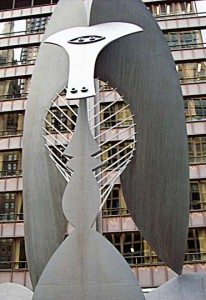 Alexandra loved the freedom of expression that she saw in Picasso’s art, unencumbered by rules. Alexandra’s career advanced rapidly from that point on. As cited on her web site:
Alexandra loved the freedom of expression that she saw in Picasso’s art, unencumbered by rules. Alexandra’s career advanced rapidly from that point on. As cited on her web site:
“She attracted the attention of art critics and the media who began telling the world about this rarest of child prodigies—an artist who had mastered drawing and color, an artist who had created a visual language of her own, in a unique, lyrical, figurative, abstract cubist manner, an artist who had only recently turned nine years old.”
In fact, the press had dubbed her, “The Petite Picasso.” In 1999, at the age of fourteen, Alexandra was selected to lead the Global Arts Initiative, involving more than one hundred countries, sponsored by the World Federation of United Nations. In her still nascent voyage, Alexandra has been a guest on numerous national television shows in the United States, including CBS Sunday Morning, NBC’s Today, The Rosie O’Donnell Show, NBC Nightly News with Tom Brokaw and The Oprah Winfrey Show.
Past Life Patterns: Picasso’s Guernica and Alexandra’s Past Life Theory
In early 2006, I tried to contact Alexandra using information provided on her website. She was still only 20 years of age at this point in time. I was put in touch with her mother, Viorica, who was open to reincarnation.
 After Born Again came out in 2006, I met Viorica and her daughter at an art exhibition that Alexandra was holding in Las Vegas. Many of the oil paintings were priced close to $100,000. Alexandra also displayed works of art created in glass and other media. The centerpiece of the exhibit was a 20 foot tall metal statue entitled, Hands and Dove, which is presented to the right. Picasso also worked in multiple media and created enormous statues such as the untitled sculpture in Chicago’s Daley Plaza, the bird like monument featured above Hands and Dove.
After Born Again came out in 2006, I met Viorica and her daughter at an art exhibition that Alexandra was holding in Las Vegas. Many of the oil paintings were priced close to $100,000. Alexandra also displayed works of art created in glass and other media. The centerpiece of the exhibit was a 20 foot tall metal statue entitled, Hands and Dove, which is presented to the right. Picasso also worked in multiple media and created enormous statues such as the untitled sculpture in Chicago’s Daley Plaza, the bird like monument featured above Hands and Dove.
Alexandra’s Day of September 11 mirrors Picasso’s Guernica
At this event, Alexandra’s manager, Ben Valenty, who has represented her from childhood, was very excited to receive a copy of Born Again, which included the case of Pablo Picasso | Alexandra Nechita. He shared with me that on his deathbed, Picasso stated that a young child would be born with his talent. I got the impression that Ben himself had wondered whether this child was Alexandra. Then he gave me a copy of her recently released book, entitled Hands and Dove: The Art of Alexandra Nechita.
When I read this book, I had further insight into this theory. Inside, I found an image of her work entitled The Day of September 11, provided above.
This is a huge painting that is the size of a wall. Not only in size, but in content, this painting appeared to be an updated version of Picasso’s Guernica. To appreciate the size of The Day of September 11, look at the left side of the painting and you will see Alexandra herself standing in front of the canvas. This painting is essentially a contemporary version of Guernica which is featured below.
Just as Guernica portrayed the horror of the Spanish city undergoing aerial bombardment, The Day of September 11 captured the horror of the destruction of the World Trade Center. Both paintings feature human beings with arms outstretched skyward. Picasso placed farm animals in his painting and depicted their annihilation, while Alexandra used doves to represent the victims of the towers, who were streaming out towards heaven. Of course, one could suggest that Alexandra simply was inspired by Guernica, but recall that she started doing Picasso like art when she was only four years old, before she had exposure to the art world.
An even more revealing Nechita painting is entitled Past Life Theory, which features the horse head found in Guernica, which is the most famous and recognizable object in Guernica. In her painting, Alexandra gave this horse female breasts and in the right-hand corner of the painting, a red question mark is prominent. By utilizing one of the most famous symbols of Picasso and title of the painting being Past Life Theory, it appears that Alexandra is musing on the question of whether Picasso has been reborn in her.
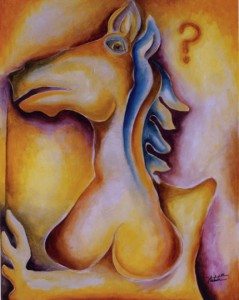 Past Life Patterns
Past Life Patterns
If the reincarnation case of Pablo Picasso | Alexandra Nechita is accepted, reflect on how these souls have demonstrated such characteristic patterns in their development across two lifetimes. Picasso and Alexandra both dove into art as toddlers and demonstrated genius already in their teenage years, becoming world renowned artists early in their lives.
Repetition of patterns is similarly observed in the case of Paul Gaugin | Peter Teekamp. Paul Gauguin and Peter Teekamp, as young men, both became carefree world travelers. They both then embarked on business careers as a way to support themselves. Gauguin and Teekamp both started painting in adulthood as a hobby. Both only decided to pursue art as a full time profession in maturity. Gauguin died poor and unrecognized and Peter, though an accomplished artist, is at this time relatively unknown.
Let us also reflect on how these two cases illustrate that we do indeed build upon accomplishments of past lifetimes. The Gauguin | Teekamp sketches, with the horses, women in circles, men in berets and Jesus on the cross—drawn from above, demonstrate that Peter Teekamp unconsciously replicated Gauguin’s artist development, but at an earlier age.
Similarly, Alexandra replicated Picasso’s development by drawing abstract figures with two faces and four eyes at the age of four. Picasso became a pioneer of the Cubist style of painting in 1907, when he was 26 years old. The media has noted that Alexandra Nechita painted in an “abstract cubist manner” when she was nine years old.
Another case that demonstrates how the pattern of being a childhood prodigy is replicated from one lifetime to another involves The Reincarnation Case of Anne Frank | Barbro Karlen, as Barbro had her first book of prose published at 12.
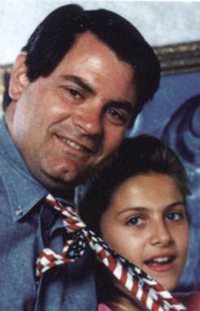

If this reincarnation case is accepted, it demonstrates the following features:
Physical Resemblance: Alexandra Nechita’s facial bone structure is consistent with that of Picasso.
Past Life Innate Talent: Alexandra Nichita was a child prodigy artist, as was Picasso. She replicated the style of Picasso in childhood, works in multiple media, as did Picasso, and in The Day of September 11, she did a contemporary version of one Picasso’s most famous paintings, Guernica. Ben Valenty, who has represented Alexandra and is featured in the picture to the right, told me that Picasso, on his death-bed, predicted that a child would be born with his talent.
Anniversary Phenomenon: Alexandra had her first art exhibit at age eight and on that same day, she first saw an exhibit of Picasso’s art.
Change of Nationality and Ethnic Affiliation from One Incarnation to Another: Picasso was born in Spain and lived in Europe, while Alexandra is a native of Romania, who lives in the United States.
Gender Change: Picasso was male who reincarnated as Alexandra, a female.

